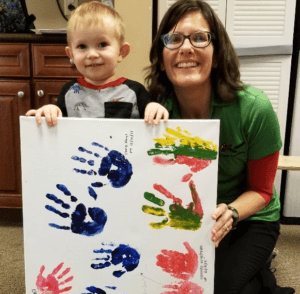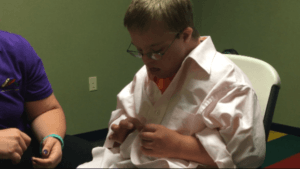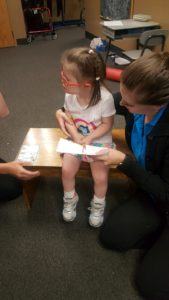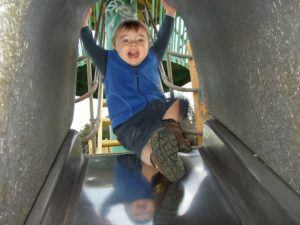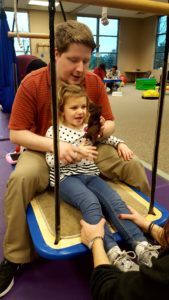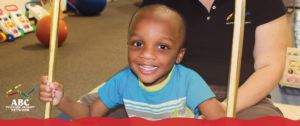Blog
 If you’ve never used Pinterest: Pinterest is a website that allows you to access the internet in a unique way by creating your own virtual cork boards of items or activities of your interest. On each cork board you can pin items from all over the internet so that you can go back to ideas you find easily for future reference. You can also browse other cork boards and repin items to your board! When you click on a “pin” you have a few choices:
If you’ve never used Pinterest: Pinterest is a website that allows you to access the internet in a unique way by creating your own virtual cork boards of items or activities of your interest. On each cork board you can pin items from all over the internet so that you can go back to ideas you find easily for future reference. You can also browse other cork boards and repin items to your board! When you click on a “pin” you have a few choices:
• First you can “like” the pin and a list of “likes” will be created in your profile for you to go back to.
• Second you can “repin” the “pin”. So if you see something you like on ABC’s page, and don’t want to forget it, you can pin it to your own board.
• Third you can click the website link on the top right of the pin and it will take you to the original website where the pin was found. At the website you may find out how to create a homemade activity, how other people are using the activity, or possibly how to purchase a specific game or toy.
The benefits of ABC’s Pinterest site: ABC is taking all the hard work out of trying to find fun home program ideas for your child to meet their goals. Visit our pinboard and you will see that we are collecting a plethora of ideas to help your child meet a variety of goals. We will be constantly adding to our pinboards so check back frequently for new ideas.
Here is a list of current pinboards and what you might find on our Pinterest page:
Games for Growing: a list of games that you may already have in your game closet at home and how they can be used to help increase skills in a variety of areas targeted in therapy. Also a great list to refer to if a birthday is coming up as the games will be both fun toys as well as educational.
Fabulous fine motor skills: a variety of ideas to help your child work on fine motor skills. Some may be toys or crafts you can do with household items.
Fun with food: Is your child a picky eater? These fun food ideas can help your child think eating those nutritious foods is a fun game or an arts and crafts project. Hopefully this board gets the brain juices flowing with how to make food FUN!
Written by: Terri Smock, MA, CCC-SLP
Read More
How many buttons can you count on the clothes you or your kids are wearing today?
Buttons are everywhere! On raincoats, rain boots, sweaters, dresses, shirts, and pants.
Starting at the age of:
___2.5 years old, it is age appropriate for kids to unbutton 1 large button independently.
___3 years old, developmentally, a child should be able to button a large or medium button on themselves independently.
___3.5 years old, buttoning up to 3 or 4 buttons independently is expected.
As a parent, do you find yourself completing your child’s buttons for them? By spending a few extra minutes helping your child who is at least 2.5 years old to complete buttons will give them an increased feeling of accomplishment and more independence with everyday tasks!
Often children have trouble completing buttons because of decreased strength in their fingers and hands, decreased eye-hand coordination, decreased visual-perceptual skills, limited movement in their hands, and decreased grasping skills. Also, limited trunk strength may limit them from sitting upright to see the buttons.
Activities that children can participate in to increase their performance with buttons include:
- Squeezing silly putty or a squishy ball to increase strength
- Picking out “treasures” hidden in silly putty or play-doh
- Stringing beads to increase visual motor skills, visual-perceptual, and grasping skills
- Picking up small items such as cheerios, raisons or puffs to increase pinching/grasping skills
- Have your child lay on his/her belly during activities to increase trunk strength
- Wheelbarrow walks to increase hand strength and movement in hands
If you have questions about your child’s development, please contact an occupational therapist at ABC Pediatric Therapy Network at 513-755-6600. We look forward to helping your child excel with their fine motor skills.
Read MoreFall tree cutting activity:
- Cut a tree trunk and branches (different sizes of rectangles) out of brown construction paper and glue it onto another piece of construction paper (you can use blue for the sky or any other color you choose)
- Cut a strip of green paper and glue it under to bottom of the tree for grass
- Cut out strips of red, orange, and yellow paper
- Cut the strips into small squares for the leaves of the tree
- Scrunch the square pieces and glue them on the branches, the grass and the paper as leaves falling from the tree
Hang it up on the refrigerator or around the house for fall decoration!

Squeeze in some fun outside activities this weekend while we still have some warm weather!! As you know, outdoor activities are a great way for children to stay fit as well as release some excess energy. Here are some gross motor activities that promote strength, motor planning, balance, reaction time and coordination.
Finding a good jungle gym is often hard to find! Sharon Woods and Winton Woods are parks in Hamilton county with fantastic jungle gyms. Pine Hills Park, Heritage Park, Corwin Nixon Park and Fleckinstein Park have great jungle gyms in Mason. West Chester and Liberty Township have very fun jungle gyms as well as Fort Liberty Park and Keehner park.
When climbing up and down a jungle gym ladder, encourage your child to have their stomach against the ladder. This makes all the right muscles work. Going up is typically no problem but be careful when your child is learning to come down a ladder. Your child may need verbal cues to look where they are placing their feet. He/she may need manual help to find the step.
Have your child climb up a slide. This encourages strengthening in the hands and legs. It also requires them to be aware of their own safety. Encourage them to look to the top of the slide first to be sure no one is there.
Monkey bars not only develop upper body strength but also encourages motor planning and weightshift so they can move across the length of the bars.
Swinging on a strap swing is grat for grip strength, trunk and abdominal stengthening and even motor planning in order to propel the swing.
Read More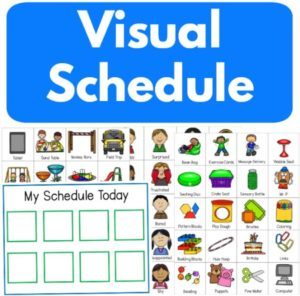 A visual schedule is something that allows children to see their day or activity in a more organized manner. These work great for kids diagnosed on the Autism Spectrum, ADHD, or anyone for that matter! The implementation of visual supports and schedules provides structure, and allows children to know what is expected of them, such as answering “what work” is expected of them and “how much work” is expected of them. This helps to alleviate stress when it comes to transitioning and allows children to see what is coming next. It allows our kids to feel better prepared and better organized, and may help to reduce behavioral problems.
A visual schedule is something that allows children to see their day or activity in a more organized manner. These work great for kids diagnosed on the Autism Spectrum, ADHD, or anyone for that matter! The implementation of visual supports and schedules provides structure, and allows children to know what is expected of them, such as answering “what work” is expected of them and “how much work” is expected of them. This helps to alleviate stress when it comes to transitioning and allows children to see what is coming next. It allows our kids to feel better prepared and better organized, and may help to reduce behavioral problems.
A visual schedule can be used for almost anything, from planning out an entire day to planning out a specific event. These work great for planning specific daily events-such as a morning or bedtime routine. A visual schedule can be made by using PECS pictures to handwritten or hand-drawn pictures! Visual supports also work in this way. Visual supports can be anything from a Venn diagram (for those school-aged kids working on language expansion), to a visual timer for children to see when time to be spent on a certain activity is up, to any other aid that our kids can see!
I like to start off therapy sessions by creating a visual schedule with my kids. I like to give them the choice of the reward activity (bubbles, jumping, bike, etc.) and I pick the structured activity. For example, if we are going to read a book (I will generally pull two and allow the child to choose-if possible), I will tell them first we are reading a book, and then we will do the desired activity of their choice. This way, it creates a structured environment that is still fun, in which they understand what will be expected of them and what the reward can be for our 30 minute session together.
It is important to note that, as is true with any treatment, there is no “one size fits all” approach! One child may need a very detailed visual schedule, while the next may need just a general layout of the day. These can be implemented in ANY environment-home, school, therapy, you name it! There are many examples of these on the Internet, or just talk to your therapist if you would like any more information about the topic!
Written by Nicole Dupont, M.A., CFY-SLP
Read MoreEvery child has behaviors. It’s the nature of being a child! I am the mother of two small children. I have been a pediatric speech-language pathologist for over six years. So you can imagine how many behaviors I have seen! Some behaviors are typical for all children. They don’t always listen the first time you tell them something, and sometimes there are tears for not getting their way. However, some behaviors are not acceptable, such as aggressive behaviors or consistent defiance. These types of behaviors could include frequent/excessive crying, hitting, kicking, biting, scratching, frequently refusing to follow directions or other unsafe behaviors such as running/climbing. So why, you think to yourself, does my child behave this way? There is always a reason behind a behavior. Your child may be seeking your attention. He/she may be seeking physical movement, a sensory need. Your child may need a more structured environment. From my perspective as a speech-language pathologist, your child may have functional communication difficulties.
Communication is key piece of a functional life. We may not all communicate in the same way, but we all communicate one way or the other. When a child is unable to functionally communicate, their world is one big uphill battle. Communication is our way of knowing what a child wants, needs, thinks and feels. So ask yourself, how does my child get want he/she wants or needs? Talking? Pointing? Get it him/herself? Crying? As parents of young children, we are caring and providing for them on a daily basis. I hear parents frequently say, “I know what he wants; I get it for him.” As parents, we know our children better than anyone else in the whole world. So much of the time, it’s true; we do know what they need or want. But what about those times when we don’t know? Those are the times when we scratch our heads. As this begins to happen more often, the child becomes frustrated, and the behaviors can start to escalate or become more frequent. After a while, the parent is frustrated and doesn’t know what to do. We have to address the child’s communication challenges.
Try these:
1. Model the words for the child. Keep it simple. “More milk.” “Cracker please.” “Help me.” Have the child attempt to repeat the words. Attempt is the key word here. Maybe your child doesn’t have the speech sounds to say certain words perfectly. That’s ok. If you say “more milk” and your child says “muh muh,” praise him and say, “Oh thank you for using your words. Here is your milk.”
2. Give choices. You don’t know what she wants. Choose a few things in the general area of where she’s pointing. Ask if she wants one of those. If so, go back to step 1 and model the words. Praise the communication attempt.
3. Show me. Some children are quick to take your hand and lead you to what they want. Once you figure it out, go back to step 1 and model the words. Praise the communication attempt.
**Be a teacher. We as parents are our child’s first teachers. In the first 3-4 years of life, they learn just about everything from you. But, don’t fear! You don’t have to be a certified teacher or therapist to teach your children well. One thing we can all do more of is talk to our children. Children are like sponges. They tend to soak up whatever is thrown their way!
• Share books together every day. Grab a few free ones from the library. Read the story. But don’t stop there. Forget the words and tell the story just by looking at the pictures. Describe what you see. If your child says a word or two, expand on it. “Ball!” “Oh yes, the boy is playing ball in the grass.” “Doggie!” “I see! The doggie is eating his food.” You’re teaching your child vocabulary and sentence structure.
• Ask questions. If you’re child can’t answer the questions, that’s ok. Model the answers for them. “What are you playing with?” “Car!” “What does the car do? Drive? Drive car fast!” “Where does the car drive? On the road!” “Who rides in the car? Mom, brother, sister” “Where do we go in the car? Grocery store! School! Work!”
• Tell what you’re doing. As parents, it seems there is always something that has to be done! Dishes, laundry, yard work! The list goes on and on. Let your child be a helper! “I’m using warm water and soap to clean this plate. Then I’ll use a towel to dry it off.” “Oh, thank you for putting the clean clothes in the basket.” Just by narrating your actions, you’re teaching your child tons of vocabulary.
***As always, consult your doctor. Pediatricians try to ask as many questions as possible regarding your child’s development when you visit. Often, they ask about the child’s communication. If they do, give a detailed description of how your child communicates. If they don’t ask, bring it up! Talk about how your child communicates and ask if it’s age-appropriate. Don’t be afraid to talk openly and honestly with your doctor about this or any issue. It’s how you and your doctor can work together to provide the best care for your child. Your doctor can help you find the people and resources your child needs. If your child has communication difficulties, speech-language therapy can help you and your child communicate and reduce or even eliminate some behaviors.
Just remember, help is out there for you.
Katy Cavanaugh, MS, CCC-SLP 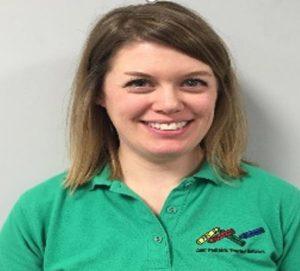
ABC Pediatric Therapy Network
[email protected]
 Skip to content
Skip to content
